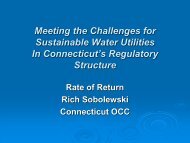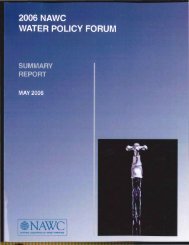BEECHER - NAWC
BEECHER - NAWC
BEECHER - NAWC
Create successful ePaper yourself
Turn your PDF publications into a flip-book with our unique Google optimized e-Paper software.
Water ComparedIndustries ComparedTable 2-7A Summary of Selected Characteristics ofthe Water IndustryRelative to the Other UtilityCharacteristic I Water ComparedTechnicalCapital intensityand longevityEconomies of scaleProduction-costprofileRationale andpotential forwheelingPhysical propertiesEconomicMarket power ofnoncore customersTrends in demandTrends in pricesTrends in costsWater is among the most capital intensive of the utility industries; percustomerinvestment is rising; water assets also tend to have very long servicelives, making long-term planning and investment essential.Water supply and treatment demonstrate substantial economies of scale, yetthese economies are not realized across the industry due to fragmentation.Water delivery requires substantial investment in transmission and distributionfacilities; in the energy sector, generation costs (including fuel) dominate thecost jlfofile.Water generally cannot be wheeled through long-distance networks because oftechnical, economic, and institutional constraints; transmission costs relative toproduction costs are much lower in the other sectors.Water is a natural resource with unique physical properties (heavy weight,incompressibility, and capacity to corrode); water is the only utility resourcethat consumers ingest.The water industry is very dependent on residential customers; the marketpower ofnoncore (nonresidential) customers (who desire competition) isgreater in the other utilitysectors.Water demand (aggregate and per capita) is very stable and opportunities forgrowth are limited; demand for other utility services is rising.Water prices are rising at a pace faster than inflation due to rising costs and, insome cases, historic underpricing; the other sectors can offer price stability ordecreases.Water costs are rising to meet the needs of an aging infrastructure, comply withpublic health standards, and expand service territories.InstitutionalOwnershipstructureRegulation,accountability, andcompetitive fieldPolicy goalsSource: Author's construct.Public ownership (water supply as "public works") and the desire for loc.alcontrol characterize the water sector; private ownership and the regionalpresence of utilities with large market shares characterize the other sectors.For the water industry, quality regulation is high but economic regulation islimited and uneven, most publicly owned systems are not regulated, and nofederal economic regulatory presence exists (compared to the other sectors);the playing field for com_petition is highly uneven.Policy goals for the water industry and for water resources are complex andless cohesive than for the other public utility sectors; water is intrinsicallyrelated to other public health and environmental concerns.<strong>NAWC</strong> 52 September 1998
















